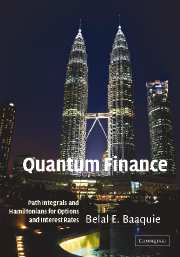Book contents
- Frontmatter
- Contents
- Foreword
- Preface
- Acknowledgments
- 1 Synopsis
- Part I Fundamental concepts of finance
- Part II Systems with finite number of degrees of freedom
- Part III Quantum field theory of interest rates models
- 7 Quantum field theory of forward interest rates
- 8 Empirical forward interest rates and field theory models
- 9 Field theory of Treasury Bonds' derivatives and hedging
- 10 Field theory Hamiltonian of forward interest rates
- 11 Conclusions
- A Mathematical background
- Brief glossary of financial terms
- Brief glossary of physics terms
- List of main symbols
- References
- Index
11 - Conclusions
Published online by Cambridge University Press: 22 February 2010
- Frontmatter
- Contents
- Foreword
- Preface
- Acknowledgments
- 1 Synopsis
- Part I Fundamental concepts of finance
- Part II Systems with finite number of degrees of freedom
- Part III Quantum field theory of interest rates models
- 7 Quantum field theory of forward interest rates
- 8 Empirical forward interest rates and field theory models
- 9 Field theory of Treasury Bonds' derivatives and hedging
- 10 Field theory Hamiltonian of forward interest rates
- 11 Conclusions
- A Mathematical background
- Brief glossary of financial terms
- Brief glossary of physics terms
- List of main symbols
- References
- Index
Summary
A wide range of topics have been covered, from stock options to forward interest rates. The definition, valuation and hedging of financial instruments have been formulated in the mathematics of quantum theory. Most of the models used in mathematical finance are based on stochastic calculus, and have been shown to belong to the class of problems that require only a finite number of degrees of freedom. Path integrals for systems with a finite number of degrees of freedom are completely finite, and can be used to compute all quantities of interest. In particular it was shown that for stock options the pricing kernel (conditional probability) can be efficiently computed using path integrals.
The Hamiltonian formulation of random systems yields many new results and insights. Barrier options, as well as path-dependent stock options, can be modelled using the concept of potentials and eigenfunctions, and the pricing kernel can be evaluated using concepts such as the completeness equation. The Hamiltonian provides a formulation of the concept of a martingale that is independent of stochastic calculus. The field theory Hamiltonian and state space were essential in obtaining the exact martingale measure for nonlinear forward interest rates.
New financial instruments, in particular path-dependent stock options, can be designed and hedged based on the Hamiltonian approach to option pricing.
Quantum field theory is required for studying systems with infinitely many degrees of freedom. In a completely general theory of the forward interest rates, at a given instant t, the forward rate f(t, x) for each x is an independent random variable, yielding a system with infinitely many degrees of freedom.
- Type
- Chapter
- Information
- Quantum FinancePath Integrals and Hamiltonians for Options and Interest Rates, pp. 282 - 283Publisher: Cambridge University PressPrint publication year: 2004



